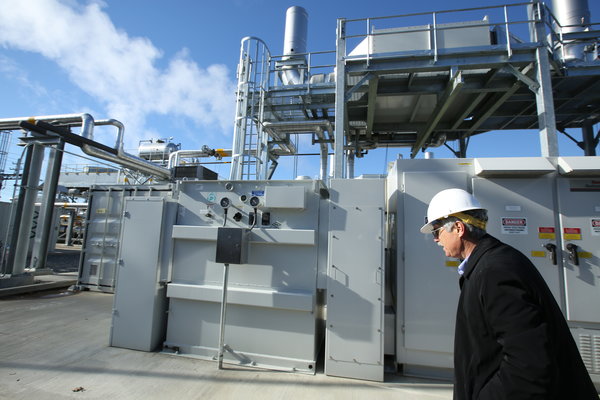 |
| Reviews and Templates for Expression We |
Capturing Carbon as a Byproduct of Running a Fuel Cell

FuelCell Energy of Danbury, Conn., says its system traps carbon produced by coal-fired plants. Credit Ozier Muhammad/The New York Times
DANBURY, Conn. — The more that engineers look, the more they find unexpected ways to capture carbon dioxide, a gas that scientists say threatens global climate stability.
Until now, most efforts to capture carbon have been expensive, in dollars and in energy. A coal-fired power plant that grabbed carbon before it escaped into the atmosphere would lose an enormous portion of its energy output in the process.
But as the strict new federal rules on carbon emissions take shape, technology is racing to find new ways. One novel approach is being demonstrated at a laboratory here, where engineers say carbon capture could be a cheap byproduct of running a fuel cell.
Deep inside a tangle of pipes, tanks, heat exchangers and miniature electrochemical reaction chambers, a fuel cell has been silently turning out electricity around the clock for about five months using a process in which one stage gives off carbon dioxide and another stage absorbs it.
A fuel cell is a chemical reactor that combines natural gas and air, and makes electricity, without combustion. In some fuel cells, carbon dioxide is routinely produced in one stage and recaptured in another.
As it is piped between the stages, the gas is at 70 percent purity, and most of the other 30 percent is innocuous steam. So the engineers at the company that built the installation, FuelCell Energy, are pulling off a chemical bait-and-switch.
They chill the carbon and steam mixture to about 40 degrees below zero, which is considered easy in the chemical world, well within the range of commercial cooling systems. At that temperature, carbon dioxide gas turns into a liquid, which is easily drained off.
But the second stage in the fuel cell is still hungry for the carbon dioxide that has now been stolen. Where to get it? From the exhaust of a coal plant. Instead of feeding the fuel cell ordinary air, the engineers supply a flow of air laced with 13 percent carbon dioxide, about the level that would come from a typical coal-burning power plant.
“It exploits a real quirk of the fuel cell,” said Anthony J. Leo, vice president of applications and advanced technology development. “It’s a different way of thinking about the problem.”
The Department of Energy sees potential in the technology, enough to provide a grant of $2.5 million for the experiment. FuelCell Energy says the next stage would be to build a unit about 300 times larger, commercial scale, at a coal plant. The technology solves only the problem of pulling carbon dioxide out of an exhaust stack — the other half is to pump it into the ground, which would be tried at a commercial-scale demonstration.
In FuelCell’s design, a coal plant adds a fuel cell unit next to its smokestack, and the fuel cell soaks up the carbon dioxide and adds power to overall output. Some energy is used — the demonstration unit here would produce eight kilowatts, enough for a midsize commercial air-conditioner, but in carbon capture mode makes only about six kilowatts — but the loss is more manageable than drawing energy from the coal plant for conventional carbon capture.
And if the Environmental Protection Agency follows through on its intent to require existing coal plants to shrink their carbon output, the company’s fuel cells could do the job in two ways, by capturing some carbon and by raising the electricity output over which the remaining carbon dioxide is spread.
“It still costs money to build this contraption,” said Arthur Bottone, president and chief executive of FuelCell Energy. “But it doesn’t cost a billion dollars.”
In some applications, the fuel cells are already commercially viable, absent any carbon capture function. Dominion, a giant power company based in Virginia, owns a 15-megawatt complex of them near the commuter rail station in Bridgeport, Conn., built and operated by FuelCell Energy. Under Connecticut rules, the electrical output is considered renewable and so can be sold at higher prices.
The carbon capture has been demonstrated only at a small scale, but it works easily with the existing commercial fuel cell technology.
The experiment also demonstrates, unexpectedly, that the fuel cell breaks up and destroys about 60 percent of the nitrogen oxides that are fed into it.
“We understand about half of that,” Mr. Leo said. The pollutant, called NOx and produced in plants that burn coal and natural gas, is an ingredient of smog and is costly to eliminate from power plant emissions.
With coal plants, another potential market is at oil wells that also produce natural gas. In California, some wells are in locations without a gas pipeline and where disposing of the gas by burning it is illegal. The fuel cell could turn the gas into electricity, for sale or for use at the rig itself, and the carbon dioxide could be pumped back into the ground to stimulate the flow of oil. Oil fields that need carbon dioxide often pay tens of dollars a ton for it.
FuelCell energy is not alone in looking for a more energy-efficient way to grab carbon dioxide; other ideas are percolating.
A nonprofit institute in Taiwan recently showed off a system that uses calcium to bind with carbon dioxide, and produce calcium carbonate, at low temperatures. When the calcium carbonate is heated, it releases the carbon dioxide again.
Other systems also use this “temperature swing” method, but the calcium-based system runs at lower temperatures. Engineers from the Taiwanese group said in an interview by telephone that they believe, based on a pilot-scale operation, that their system could capture carbon at $30 a ton, half the cost of some other systems.
|
|
|
|
Copyright 2011 Energy and Technical Services Ltd. All Rights Reserved. Energyts.com |